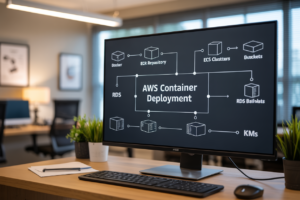Are you struggling to keep your data safe in the cloud? 🔒 With the ever-growing threat landscape, securing your AWS storage and data management services has never been more critical. From S3 buckets to Glacier archives, each service requires a unique approach to ensure your valuable information remains protected.
Imagine the peace of mind that comes with knowing your data is fortified against unauthorized access, data breaches, and accidental leaks. By implementing AWS security best practices, you can transform your storage infrastructure into an impenetrable fortress. But where do you start? 🤔
In this comprehensive guide, we’ll dive deep into the world of AWS storage security. We’ll explore best practices for S3, EBS, EFS, FSx, and Glacier, empowering you to create a robust security strategy across all your AWS storage services. From understanding the nuances of each service to implementing cross-service security measures and leveraging automation, you’ll learn everything you need to keep your data safe and compliant. Let’s embark on this journey to bulletproof your AWS storage and data management!
Understanding AWS Storage Services
A. Overview of S3, EBS, EFS, FSx, and Glacier
AWS offers a diverse range of storage services to meet various data management needs. Let’s explore the key features of each:
| Service | Type | Use Cases |
|---|---|---|
| S3 | Object Storage | Static website hosting, data archiving, backup |
| EBS | Block Storage | EC2 instance storage, databases |
| EFS | File Storage | Shared file systems, content management |
| FSx | Managed File System | Windows and Lustre workloads |
| Glacier | Long-term Archival | Data archiving, compliance storage |
B. Key features and use cases
- S3 (Simple Storage Service): Offers scalable object storage with 99.999999999% durability. Ideal for storing large amounts of unstructured data.
- EBS (Elastic Block Store): Provides persistent block-level storage volumes for EC2 instances. Perfect for databases and applications requiring low-latency access.
- EFS (Elastic File System): Offers scalable, elastic file storage for EC2 instances. Great for shared file systems and content management systems.
- FSx: Provides fully managed file systems optimized for specific workloads. FSx for Windows File Server supports Windows-based applications, while FSx for Lustre is designed for high-performance computing.
- Glacier: Designed for long-term data archiving with extremely low costs. Suitable for compliance requirements and infrequently accessed data.
C. Security challenges for each service
Each AWS storage service comes with its unique security considerations:
-
S3:
- Ensuring proper bucket policies and ACLs
- Preventing unauthorized access and data leaks
- Implementing encryption at rest and in transit
-
EBS:
- Securing data at rest through encryption
- Managing access to EBS snapshots
- Protecting against unauthorized volume attachments
-
EFS:
- Implementing proper network security groups
- Managing file system policies and access points
- Ensuring encryption for data in transit and at rest
-
FSx:
- Securing Windows file shares (for FSx for Windows)
- Managing access control for high-performance workloads (FSx for Lustre)
- Implementing encryption and network isolation
-
Glacier:
- Securing data during long-term storage
- Managing access controls for archived data
- Ensuring compliance with data retention policies
Now that we have an overview of AWS storage services and their security challenges, let’s dive into implementing S3 security best practices.
Implementing S3 Security Best Practices
Bucket policies and access control lists
Amazon S3 offers robust security controls through bucket policies and Access Control Lists (ACLs). Bucket policies are JSON-based rules that define who can access your S3 resources and what actions they can perform. ACLs, on the other hand, provide a legacy method for controlling access at the object level.
- Key features of bucket policies:
- Fine-grained access control
- Support for IAM roles and users
- Ability to restrict access based on IP ranges
- Integration with AWS Organizations
Server-side encryption options
S3 provides multiple server-side encryption options to protect your data at rest:
| Encryption Type | Description | Use Case |
|---|---|---|
| SSE-S3 | Amazon-managed keys | Default option, easy to use |
| SSE-KMS | AWS Key Management Service | Advanced key management |
| SSE-C | Customer-provided keys | Full control over encryption keys |
Versioning and object lifecycle management
Enabling versioning on your S3 buckets provides an additional layer of data protection. It allows you to preserve, retrieve, and restore every version of every object in your bucket. Coupled with lifecycle management, you can automate the transition of objects between storage classes or set up expiration rules.
Cross-region replication for data resilience
Cross-region replication automatically copies objects from one bucket to another in a different AWS Region. This feature enhances data availability and disaster recovery capabilities. To implement:
- Enable versioning on both source and destination buckets
- Create a replication rule specifying the source and destination
- Configure appropriate IAM roles for replication
- Monitor replication status using S3 management console or AWS CLI
By implementing these S3 security best practices, you can significantly enhance the protection of your data stored in Amazon S3. Next, we’ll explore how to secure Elastic Block Store (EBS) volumes, another crucial component of AWS storage services.
Securing Elastic Block Store (EBS) Volumes
Encryption at rest and in transit
Encryption is a crucial aspect of securing Elastic Block Store (EBS) volumes. AWS offers robust encryption options for both data at rest and in transit. For data at rest, EBS encryption uses AWS Key Management Service (KMS) to create and manage encryption keys. This ensures that your data remains protected even when the volume is not in use.
| Encryption Type | Description | Key Management |
|---|---|---|
| At Rest | Encrypts data stored on EBS volumes | AWS KMS |
| In Transit | Encrypts data moving between EC2 instances and EBS volumes | TLS/SSL |
To enable encryption for new EBS volumes:
- Select the “Encrypt this volume” option during volume creation
- Choose a KMS key or use the default AWS managed key
- Attach the encrypted volume to an EC2 instance
For existing unencrypted volumes:
- Create a snapshot of the volume
- Create a new encrypted volume from the snapshot
- Replace the original volume with the encrypted one
IAM roles and permissions
Implementing proper IAM roles and permissions is essential for controlling access to EBS volumes. By following the principle of least privilege, you can ensure that users and applications have only the necessary permissions to perform their tasks.
Key IAM best practices for EBS security:
- Create specific IAM roles for EC2 instances that need to access EBS volumes
- Use IAM policies to restrict volume creation, modification, and deletion
- Implement resource-level permissions to control access to specific EBS volumes
- Regularly audit and review IAM permissions to maintain a secure environment
Snapshot management and security
EBS snapshots are point-in-time copies of your volumes, providing an effective way to back up and restore data. However, proper management and security of these snapshots are crucial to prevent unauthorized access or data leaks.
Best practices for EBS snapshot security:
- Encrypt snapshots using AWS KMS
- Implement lifecycle policies to automate snapshot creation and deletion
- Use IAM policies to control snapshot sharing and copying
- Regularly audit snapshot permissions and remove unnecessary access
By implementing these security measures for EBS volumes, you can significantly enhance the protection of your data stored in AWS. Remember to regularly review and update your security practices to stay ahead of potential threats and vulnerabilities.
Enhancing Amazon EFS Security
Network access control with security groups
Amazon EFS security begins with robust network access control. Security groups act as virtual firewalls, controlling inbound and outbound traffic to your EFS file systems. Here’s how to effectively use security groups:
- Create a dedicated security group for EFS
- Allow inbound NFS traffic (port 2049) only from trusted sources
- Implement the principle of least privilege
| Security Group Rule | Type | Protocol | Port Range | Source |
|---|---|---|---|---|
| Inbound | NFS | TCP | 2049 | Trusted IP ranges |
| Outbound | All traffic | All | All | 0.0.0.0/0 |
Encryption options for EFS
Encryption is crucial for protecting data at rest and in transit. Amazon EFS offers two types of encryption:
- Encryption at rest: Uses AWS Key Management Service (KMS) to encrypt data
- Encryption in transit: Utilizes TLS to secure data during transfer
To enable encryption:
- Select “Enable encryption” when creating a new file system
- Use AWS KMS customer managed keys for granular control
- Enable in-transit encryption by mounting the file system using TLS
File system policies and access points
File system policies and access points provide fine-grained access control:
- Use IAM-based policies to manage access at the file system level
- Create access points to enforce user identity, root directory, and permissions
Example access point configuration:
- Root directory: /marketing
- User ID: 1000
- Group ID: 1000
- Permissions: 0755
By implementing these security measures, you can significantly enhance the security posture of your Amazon EFS file systems. Next, we’ll explore how to protect data with Amazon FSx, another powerful storage service in the AWS ecosystem.
Protecting Data with Amazon FSx
Windows vs. Lustre security considerations
When it comes to protecting data with Amazon FSx, understanding the security considerations for both Windows File Server and Lustre is crucial. Let’s compare these two file systems:
| Feature | FSx for Windows | FSx for Lustre |
|---|---|---|
| Authentication | Active Directory integration | POSIX-compliant |
| Access Control | NTFS permissions | POSIX permissions |
| Encryption | At-rest and in-transit | At-rest only |
| Network Protocol | SMB | Lustre protocol |
FSx for Windows offers robust security features tailored for Windows environments, while FSx for Lustre focuses on high-performance computing workloads with different security requirements.
Encryption and key management
Encryption is a critical aspect of data protection in Amazon FSx. Both file systems support:
- At-rest encryption using AWS Key Management Service (KMS)
- Customer-managed keys for enhanced control
For FSx for Windows, in-transit encryption is available through SMB encryption. Key rotation and auditing are essential practices to maintain strong encryption.
Network isolation and VPC configuration
To ensure optimal security for your Amazon FSx file systems:
- Deploy file systems in private subnets
- Use security groups to control inbound and outbound traffic
- Implement VPC peering or AWS Direct Connect for secure access from on-premises networks
- Enable VPC Flow Logs for network traffic monitoring
By carefully configuring your VPC and network settings, you can significantly enhance the security posture of your FSx deployments. Next, we’ll explore how to safeguard long-term archives with Glacier, another crucial component in AWS storage security.
Safeguarding Long-Term Archives with Glacier
Vault lock policies
Vault lock policies are a crucial component of Amazon Glacier’s security framework, providing an additional layer of protection for your long-term archives. These policies allow you to enforce compliance controls that cannot be changed or deleted, ensuring the integrity of your data retention and deletion practices.
| Policy Feature | Description |
|---|---|
| Immutability | Once locked, policies cannot be modified or deleted |
| Time-based retention | Specify minimum and maximum retention periods |
| Legal hold | Prevent data deletion during investigations or audits |
To implement an effective vault lock policy:
- Define your compliance requirements
- Create a policy document in JSON format
- Initiate the lock process with a 24-hour cool-down period
- Complete the lock to enforce the policy permanently
Data retrieval security
When retrieving data from Glacier, it’s essential to maintain security throughout the process. Implement these best practices:
- Use IAM roles to control who can initiate retrieval jobs
- Enable CloudTrail logging for all Glacier API activities
- Implement Multi-Factor Authentication (MFA) for sensitive operations
- Utilize VPC endpoints to keep data transfer within the AWS network
Encryption and access controls
Glacier automatically encrypts data at rest using AES-256 encryption. However, to enhance security:
- Use AWS Key Management Service (KMS) for customer-managed keys
- Implement server-side encryption with customer-provided keys (SSE-C)
- Apply IAM policies to restrict access to specific vaults
- Use bucket policies and ACLs for granular control over S3 Glacier Select queries
By implementing these security measures, you can ensure that your long-term archives in Glacier remain protected and compliant with your organization’s data governance policies. Next, we’ll explore cross-service security strategies to create a comprehensive security posture across your AWS storage services.
Cross-Service Security Strategies
IAM best practices for storage services
Implementing robust IAM (Identity and Access Management) practices is crucial for securing AWS storage services. Here are some key best practices:
- Use IAM roles instead of long-term access keys
- Implement the principle of least privilege
- Regularly rotate access keys and credentials
- Enable MFA for all IAM users
- Use IAM policy conditions for fine-grained access control
| IAM Best Practice | Description | Benefit |
|---|---|---|
| Use IAM roles | Assign roles to EC2 instances or services | Eliminates need for storing credentials |
| Least privilege | Grant minimum permissions necessary | Reduces potential impact of compromised accounts |
| Key rotation | Change access keys periodically | Minimizes risk if keys are exposed |
| MFA | Require multi-factor authentication | Adds an extra layer of security |
| Policy conditions | Use conditions in IAM policies | Enables context-based access control |
Monitoring and auditing with CloudTrail and CloudWatch
Effective monitoring and auditing are essential for maintaining the security of your AWS storage services. CloudTrail and CloudWatch work together to provide comprehensive visibility into your storage environment.
CloudTrail records API calls and events related to your storage services, while CloudWatch collects and tracks metrics, logs, and events. By leveraging these services, you can:
- Track user activity and API usage across storage services
- Set up alerts for suspicious activities or policy violations
- Monitor performance metrics and resource utilization
- Analyze access patterns and identify potential security threats
Using AWS Config for compliance
AWS Config is a powerful tool for assessing, auditing, and evaluating the configuration of your AWS resources, including storage services. It helps ensure compliance with internal policies and regulatory standards. Key features include:
- Continuous monitoring and recording of configuration changes
- Evaluating resource configurations against predefined rules
- Generating compliance reports and notifications
- Integrating with other AWS services for automated remediation
Implementing least privilege access
The principle of least privilege is fundamental to securing your AWS storage services. It involves granting users and services only the minimum permissions necessary to perform their tasks. To implement least privilege access:
- Regularly review and audit IAM policies
- Use IAM Access Analyzer to identify overly permissive policies
- Implement attribute-based access control (ABAC) for dynamic permissions
- Utilize AWS Organizations for centralized policy management
By following these cross-service security strategies, you can significantly enhance the protection of your AWS storage and data management services. Next, we’ll explore how automation and Infrastructure as Code can further strengthen your security posture.
Automation and Infrastructure as Code
Using AWS CloudFormation for secure deployments
AWS CloudFormation offers a powerful way to automate the deployment of secure storage and data management solutions. By defining your infrastructure as code, you can ensure consistent and repeatable security configurations across your AWS environment.
Key benefits of using CloudFormation for secure deployments:
- Standardization of security controls
- Version control for infrastructure changes
- Automated compliance checks
- Reduced human error in configuration
Here’s a sample CloudFormation template snippet for creating a secure S3 bucket:
Resources:
SecureS3Bucket:
Type: AWS::S3::Bucket
Properties:
BucketName: my-secure-bucket
PublicAccessBlockConfiguration:
BlockPublicAcls: true
BlockPublicPolicy: true
IgnorePublicAcls: true
RestrictPublicBuckets: true
BucketEncryption:
ServerSideEncryptionConfiguration:
- ServerSideEncryptionByDefault:
SSEAlgorithm: AES256
Leveraging AWS Security Hub
AWS Security Hub provides a comprehensive view of your security posture across your AWS accounts. It can be integrated with your storage services to enhance overall security monitoring and compliance.
Benefits of using Security Hub:
| Feature | Description |
|---|---|
| Centralized Dashboard | Single pane of glass for security findings |
| Automated Checks | Continuous evaluation against security standards |
| Integration | Works with other AWS and third-party security tools |
| Custom Actions | Automate responses to security events |
Implementing automated security checks
Automated security checks are crucial for maintaining a robust security posture. Tools like AWS Config and AWS Lambda can be used to create custom rules and perform regular audits of your storage configurations.
Key areas for automated checks:
- Encryption settings
- Access policies
- Logging and monitoring configurations
- Compliance with industry standards
By implementing these automation strategies, you can significantly enhance the security of your AWS storage and data management solutions while reducing the operational overhead of manual security management.
Securing your AWS storage and data management services is a critical aspect of maintaining a robust cloud infrastructure. By implementing best practices for S3, EBS, EFS, FSx, and Glacier, you can significantly enhance your data protection and compliance posture. Remember to leverage cross-service security strategies and automation tools to streamline your security efforts and maintain consistency across your AWS environment.
As you continue to evolve your cloud security strategy, stay informed about the latest AWS security features and industry best practices. Regularly review and update your security configurations, and consider implementing infrastructure as code to ensure scalable and repeatable security measures. By prioritizing data protection and following these guidelines, you’ll be well-equipped to safeguard your valuable information assets in the AWS cloud.



















